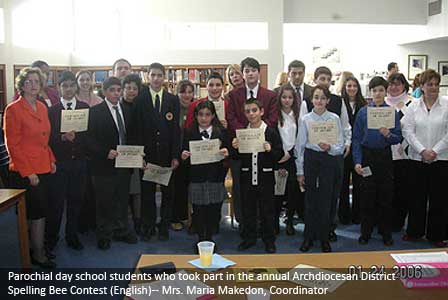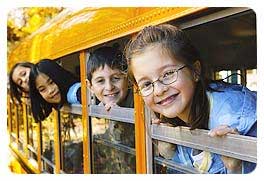It includes a mural of student drawings on the events of 1821 posted on the basement walls (“I love this, I’m trying to build a gallery of the kids’ artwork”), a glimpse into the computer room (“We’re not hooked onto the Internet and we don’t have CD-ROMS,” the teacher admits apologetically), and through a cloud of incense a snatch heard of the “paraklisi” being given in the church by Reverend Nikodom Gromoff, the church’s associate pastor, who is Russian.

“He’s wonderful, he also does my religious instruction for the upper grades,” says Yeannakopoulos, back in his small, cramped office decorated with posters of the Greek islands and of icons. “My own feeling,” he adds, “is that we are now becoming--and what schools across the nation too are becoming--is an orthodox rather than a strictly Greek Orthodox parochial school. We (in Brooklyn) are catering to the needs of the Orthodox community which is Russian, Serbian, Ukrainian, Moldavian. That is the situation here.”
 Seventy percent of the school’s 140 kids are Russian (one boy using the principal’s phone spoke in Russian) and for years there’s been a sign in the schoolyard advertising the school in Russian.
Seventy percent of the school’s 140 kids are Russian (one boy using the principal’s phone spoke in Russian) and for years there’s been a sign in the schoolyard advertising the school in Russian.
“At all of our schools we now have non-Greeks,” admits Maria Makedon of the Archdiocese’s Department of Greek Education based in New York. “In the Bronx, for example, we have students from the Muslim population that lives in the area.”
In Manhattan there are Hispanics attending the C. Goulandris-T. Tsolainos school of St. Spyridon and Chinese at The Cathedral School; in Flushing, Queens there are Polish and Russian students enrolled in the William Spyropoulos Day School of St. Nicholas. At the Annunciation Orthodox School in Houston, Texas, only a third of the approximately 600 students are Greek and the Florida parochial schools have scheduled Greek only as an after school activity.
“In Texas and California these are not ‘Greek’ schools,” she says. “They are parochial schools, we can say, Orthodox parochial schools.”
 Not all of the estimated 27 parochial day schools in the United States serving close to 6,600 students, and almost 314 Greek afternoon schools with 20,000 kids, have such a student ratio of non-Greeks (Koraes in Chicago had only two Serbian Orthodox out of a student body of 230). But many of the schools, while clinging to a standard one hour per-day per-grade class in Greek, are now coping with a mixed-ethnic and sometimes mixed-religious population.
Not all of the estimated 27 parochial day schools in the United States serving close to 6,600 students, and almost 314 Greek afternoon schools with 20,000 kids, have such a student ratio of non-Greeks (Koraes in Chicago had only two Serbian Orthodox out of a student body of 230). But many of the schools, while clinging to a standard one hour per-day per-grade class in Greek, are now coping with a mixed-ethnic and sometimes mixed-religious population.
“I think what’s happening to Three Hierarchs is what’s going to happen to the schools generally speaking,” says Yeannakopoulos. “I think the salvation is if we become as all-inclusive as the Catholic schools, as far as ethnic groups go.”
But with diminishing enrollment and funds can the schools adapt fast enough (and will traditionalists allow them) before the students and the money runs out? Several of the day schools are running deficits or have to supplement tuitions with money raised from special events and from the parish church (struggling to maintain its own foothold, and for the Archdiocese in America whose entire $12 million budget last year was roughly equivalent to the operating budget of the combined 27 schools). So school budgets are skimpy and operating costs kept to a minimum.
“But there’s a price to pay for that,” says Yeannakopoulos, “and that’s in the way of salaries.” The 78-year-old Yeannakopoulos has a master’s degree from Harvard and is a retired public school superintendent but didn’t end his retirement for the money. “I could never afford this job if this was my sole means of income,” he admits, with a sheepish smile. “I have a really strong commitment to my heritage. And what I’m doing here is really a memorial to my parents. Most of the schools couldn’t afford my background.”
But with all their ills, and often despite them, the schools have produced some remarkable results, as the Rassias Commission report confirmed a few years ago: “We were impressed by the warm, caring environment created by the faculty administration in some of the schools we visited, by the excellent rapport between students and teachers, the exceptionally good behavior of the children, and by the intelligent answers given to our questions...”
Chicago parochial schools, to cite one major chain in the parochial system, continue to produce outstanding students “Koraes and Socrates produce students that rank very high in the high schools they attend,” says Dr. Andrew Kopan, who taught education at DePaul University and was principal of Koraes for 15 years. “They’re always in honors, because we have a selective clientele of students that come from homes that believe in education. And our schools are associated closely with the church and parish and there’s supervision and proper deportment because of the nature of the school and the study habits.”
And at the college level, Greek studies are proliferating: there are at least 36 programs across the country, including at Harvard, Columbia and Princeton, sometimes established with money raised from the Greek community, as was done at Stockton State in 1995.
“According to U.S. statistics, the two most educated ethnic groups are the Jewish and the Greek,” says Dr. Speros Vryonis, Jr. of the Vyronis Center in California. “And they have the highest average per capita income. Now those didn’t come out of nothing. It was as if the Greek immigrant was made for America and vice versa.”